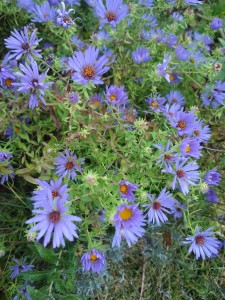 In my part of the world it has been raining ceaselessly—or so it seems—for days on end. The diminishing minutes of daylight are further diminished by the perpetual cloud cover. The garden is not just soggy, it is drowning. If this weather keeps up, some of us will be starting our annual bout of seasonal affective disorder early this year.
In my part of the world it has been raining ceaselessly—or so it seems—for days on end. The diminishing minutes of daylight are further diminished by the perpetual cloud cover. The garden is not just soggy, it is drowning. If this weather keeps up, some of us will be starting our annual bout of seasonal affective disorder early this year.
Of course, there is always a flip side. The water lovers, like the hydrangeas, are probably in hog heaven, with roots luxuriating in the wet soil and branches gearing up for a glorious season of bloom in the late spring next year. The hydrangeas only get seasonal affective disorder when we have a hard frost in March. I am quite sure they are not sentient enough to worry about that in September.
The rain makes me mourn for my beautiful New England asters. Right now, they are at the peak of bloom, but the constant rain bows their proud stems and reduces them to vague dots of color in a sea of wet leaves.
I like to think that my garden is lovely throughout the growing season, with interesting plants and lots of blooms. However, it really has two moments of absolute, unadulterated glory. The first is in spring, when hundreds of daffodils and companion plants burst out of the ground and open up. The second is in early fall, when the hundreds of New England asters open up, their numbers augmented with some plantings of Aster x frikartii ‘Monch’. On a sunny day, the display looks like an impressionist painting, with clouds of blooms in varying shades of pink, from palest shell pink to fuchsia. The sky blue of the ‘Monch’ asters complements the blue overtones in the petals of the darker New England aster flowers. On a sunny day, the scene viewed from the second floor of my house reminds me of the American Impressionist Childe Hassam’s paintings of Celia Thaxter’s garden on Appledore Island off the cost of New Hampshire. Often in the aster season, the local dog walkers, who go by the front garden every day, are lavish in their praise of the autumn spectacle.
Right now those same dog walkers hurry by, and the scene is more reminiscent of Hassam’s famous “The Avenue in the Rain”, which shows a line of American flags in a downpour, seemingly about to melt into their own reflections.
But the rain is not the only affliction besetting my asters. Like many plant genera, New England asters, which are native to North America, are also suffering from the machinations of plant taxonomists, who have unceremoniously removed them from the aster genus and placed them in a new genus with the ungainly name, symphyotrichum. Five years ago, my lovely Aster novae-angliae ‘Alma Potschke’ was transformed into Symphyotrichum novae-angliae ‘Alma Potschke’. I am thankful that the plants were not aware of the change, as it might have sent them into terminal decline.
For all the rhapsodizing that I do about the asters on sunny fall days, there are other times when I nearly lose patience with them. ‘Alma Potschke’, the pink-flowered progenitor of the majority of my plants, is a prolific self-seeder, which is why I have so many New England asters. In the spring, hundreds of babies start appearing everywhere, in a way that is so intrusive that some of them have to be pulled out while they are still small. As the growing season progresses, they shoot up, with tall stems adorned with a profusion of small green leaves. In dry conditions, those stems and leaves readily turn brown and ugly, making for unsightly, gangly plants. At all times, they grow rapidly, requiring the “Chelsea chop” in late May to keep them from getting completely out of bounds. I usually cut them back again in July so the stems branch out and produce more flowers. The deer frequently help with this because they find asters delectable, but they are somewhat less than selective in their pruning methodology.
New England asters are classic field flowers and in their native situations, no one cares about brown, leggy stems and ungainly growth habits. Quite frankly, they appear weedy. As a suburbanite, I sometimes feel that I should apologize to the local dog walkers for the way my asters present themselves from April through the end of August. I forget those feelings in early September, which ensures the survival of my front garden.
I am grateful that the garden fashion world has recently turned towards “rewilding” and acceptance of less tidiness in beds and borders. I hope the dog walkers know about it.
My asters and I will fit right in.
